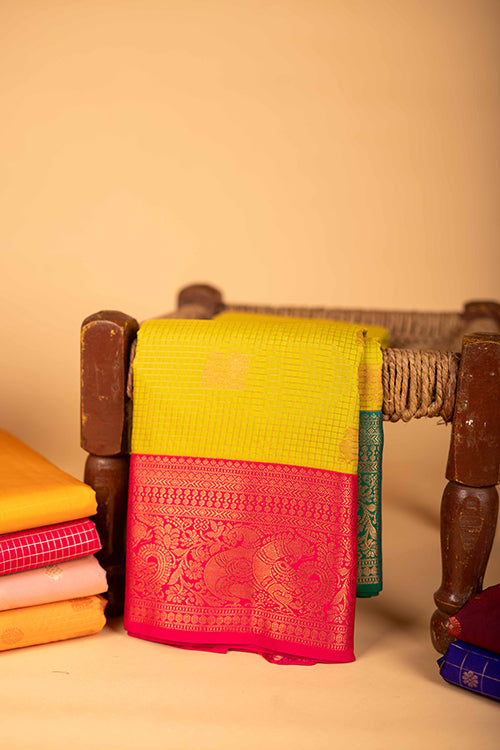Choosing the right saree for a haldi ceremony involves considering the significance of the event, the cultural context, and the practical aspects of the celebration. The haldi ceremony is a joyful pre-wedding ritual in Indian culture where turmeric paste is applied to the bride and groom’s body to enhance their glow and bless them with auspiciousness.
Significance of The Yellow Saree
 The significance of a yellow saree in a wedding can vary depending on the cultural context and traditions of the region. In some cultures and regions, yellow holds special importance and is associated with various meanings and symbolism related to weddings. Here are a few examples of the significance of a yellow saree in weddings:
The significance of a yellow saree in a wedding can vary depending on the cultural context and traditions of the region. In some cultures and regions, yellow holds special importance and is associated with various meanings and symbolism related to weddings. Here are a few examples of the significance of a yellow saree in weddings:
- Hindu Weddings: In Hindu weddings, yellow is often associated with the color of turmeric, which holds great cultural and religious significance. Turmeric is considered auspicious and is used in various pre-wedding ceremonies and rituals. The yellow saree may be worn by the bride during pre-wedding functions like the Haldi ceremony, where a paste made from turmeric is applied to the bride and groom’s body to cleanse and purify them before the wedding.
- South Indian Weddings: In some South Indian communities, yellow is considered an auspicious color and may be worn by the bride on the wedding day or during pre-wedding ceremonies like the Mehndi or Haldi functions.
- Bengali Weddings: In Bengali culture, the bride traditionally wears a yellow saree with a red border, known as “Basanti Saree,” during the pre-wedding ritual called “Snan.” This ritual involves the bride taking a ceremonial bath before the wedding.
- Rajasthani and Gujarati Weddings: In these regions, the bride may wear a yellow saree with intricate embroidery or embellishments, reflecting the vibrant and colorful cultural heritage of the area.
- Modern Trends: In contemporary weddings, brides may choose to wear a yellow saree as a fashion statement or a personal preference without specific traditional or cultural significance.
It’s important to note that the significance of colors and their association with weddings can vary significantly across different cultures and regions. Therefore, the meaning of a yellow saree in a wedding context should be understood within the specific cultural and regional context in which it is being worn. As cultural practices and customs continue to evolve, the significance of certain colors or attire in weddings may also change over time.
What is the Haldi Ceremony?
The Haldi ceremony, also known as the Pithi ceremony or Haldi rasam, is a traditional pre-wedding ritual celebrated in India and some other South Asian countries. This ceremony is typically held a day before the wedding and is an essential part of the overall wedding festivities.
The Haldi ceremony involves applying a paste made from turmeric, sandalwood, rosewater, and other natural ingredients to the bride and groom’s body. The paste is usually prepared by the family members and close friends of the couple, and its bright yellow color is considered auspicious and believed to bring good luck and purity.
 The application of haldi paste (turmeric) to the bride and groom’s body during this ceremony is believed to have several health benefits too:
The application of haldi paste (turmeric) to the bride and groom’s body during this ceremony is believed to have several health benefits too:
- Natural Antiseptic: Turmeric has natural antiseptic and antimicrobial properties, which can help cleanse and disinfect the skin. Applying turmeric paste to the body can help reduce the chances of infections and promote skin health.
- Skin Benefits: Turmeric is known for its anti-inflammatory and antioxidant properties. When applied to the skin, it may help reduce inflammation, soothe skin irritations, and promote a healthy glow.
- Detoxification: Turmeric is believed to aid in detoxification by supporting liver function. The application of turmeric paste to the skin during the Haldi ceremony is considered a way of detoxifying the body before the wedding.
- Stress Relief: The Haldi ceremony is often a joyful and celebratory occasion. The act of applying turmeric paste to the body can have a relaxing effect and help reduce stress and pre-wedding jitters.
- Symbolic Purification: Beyond the physical benefits, the Haldi ceremony holds symbolic value in many cultures. It is considered a way of purifying and blessing the bride and groom before their wedding, spiritually preparing them for their new life together.
- Boosting Immunity: Some traditional beliefs suggest that the application of turmeric paste may help boost the immune system, providing additional protection against illnesses.
During the ceremony, the bride and groom are seated separately, and their family and friends take turns applying the Haldi paste on their face, hands, and feet. It is a beautiful celebration filled with laughter and music. After the application of the paste, the couple usually leaves it on for a certain period before washing it off.
Tips to select the right saree for haldi ceremony
- Color: Opt for bright and cheerful colors like yellow, orange, or any vibrant hue that complements the theme of the haldi ceremony. Yellow, in particular, is a popular choice as it symbolizes prosperity and happiness.
- Fabric: Choose a comfortable fabric like silk cotton, linen, or lightweight silk. Since the haldi ceremony usually takes place during the day and involves lots of festivities, it’s essential to wear a breathable and easy-to-move-in saree.
- Design and Embellishments: Haldi ceremonies are typically casual and laid-back affairs, so go for simple and elegant designs. Avoid heavy embellishments as they may get messy during the application of haldi.
- Prints: Floral prints and motifs can be an excellent choice for a haldi ceremony saree, as they reflect the festive spirit and bring out the celebratory mood.
- Borders and Pallu: Opt for sarees with minimal or borderless. This will prevent the borders from getting stained with haldi paste. However, if you prefer borders, choose ones that are easy to clean.
- Blouse: Consider pairing your saree with a comfortable and well-fitted blouse. You may choose a matching blouse in a complementary color or experiment with contrasting colors.
- Ease of Draping: Choose a saree that you can easily drape and manage during the ceremony. Since haldi ceremonies can be fun and lively, you’ll want a saree that allows you to move freely and participate in the festivities comfortably.
- Accessories: Keep the accessories minimal, as the focus should be on the saree and the ceremony. Opt for light jewelry pieces like jhumkas (traditional Indian earrings) and bangles that complement your outfit.
- Footwear: Consider wearing comfortable and easy-to-walk-in footwear, as you might be on your feet for an extended period during the haldi ceremony.
Different styles to drape your saree for haldi ceremony
Indeed, there are numerous saree draping styles, each reflecting the unique cultural heritage of different regions in India and other South Asian countries. You can try and sizzle your look by experimenting with some unique yet culturally rich drape styles that would make you stand out in the yellow party but still keep you deeply connected to the rich Indian culture.
Here are some popular saree draping styles:
- Nivi Style (Classic Style): The Nivi style is the most common and widely known saree draping style from Andhra Pradesh. It involves pleating and tucking the saree at the waist and flaunting the pallu over the left shoulder.
- Bengali Style: The Bengali style drapes the pallu in the front from the left shoulder and then takes it around the waist to the right side. This style is distinctive as the pallu is usually draped without pleats.
- Gujarati/Rajrani Style: Popular in Gujarat and Rajasthan, this style involves pleating the saree at the back and bringing the pallu to the front over the right shoulder.
- Maharashtrian/Nauvari Style: This style is worn in Maharashtra and involves draping the saree between the legs like a dhoti and then wrapping it around the waist. The pallu is taken over the left shoulder and tucked in the waist.
- Kodagu Style (Coorgi Style): This style is typical of the Kodagu region in Karnataka. The saree is draped in a manner that forms pleats at the back and has the pallu brought to the front over the right shoulder.
- Tamilian Style/Madisar: Worn by Tamil Brahmin women, the saree is draped in a unique way that involves two separate pieces of cloth, creating a saree with a long pleated portion and a shorter pallu.
- Assamese Style: In Assam, the saree is draped with the pleats at the back, and the pallu is brought from the back to the front over the right shoulder.
- Lehenga Style: This modern style involves draping the saree like a lehenga skirt, with pleats tucked at the front, and the pallu taken over the left shoulder.
- Mermaid/Fishtail Style: This trendy draping style is similar to the lehenga style, but the pleats are arranged in a way that resembles a fishtail or mermaid tail.
- Mumtaz Style: Inspired by the Bollywood actress Mumtaz, this style involves creating tight, multiple pleats at the front and tucking the pallu in a decorative manner.
These are just a few examples of the many saree draping styles found across different regions and communities. Each style adds its own unique touch and charm to the saree, making it a versatile and timeless attire.
Conclusion
Remember, the haldi ceremony is a time to celebrate, have fun, and make beautiful memories. Choose a saree that not only reflects the significance of the occasion but also makes you feel happy and confident throughout the event.



























































